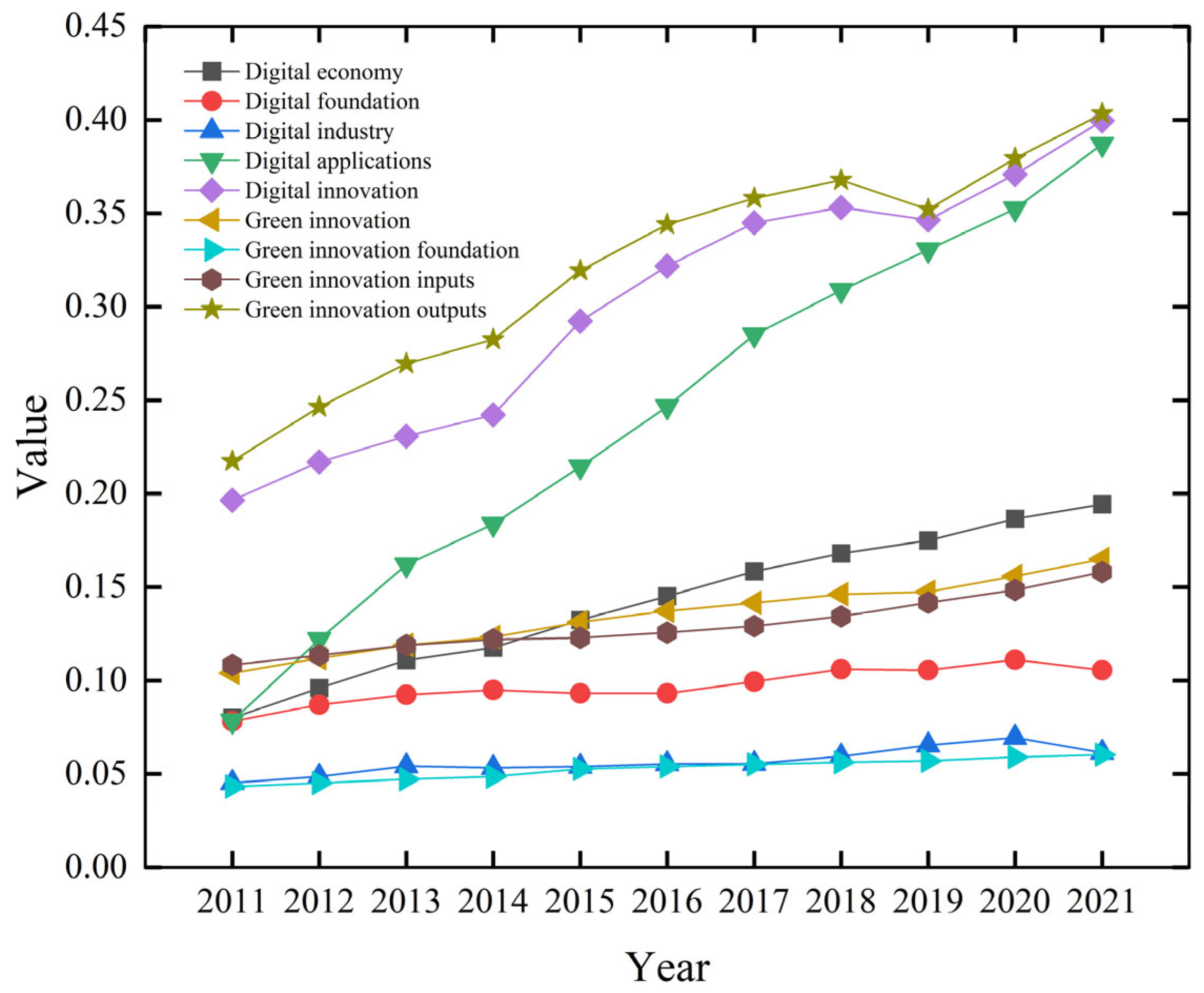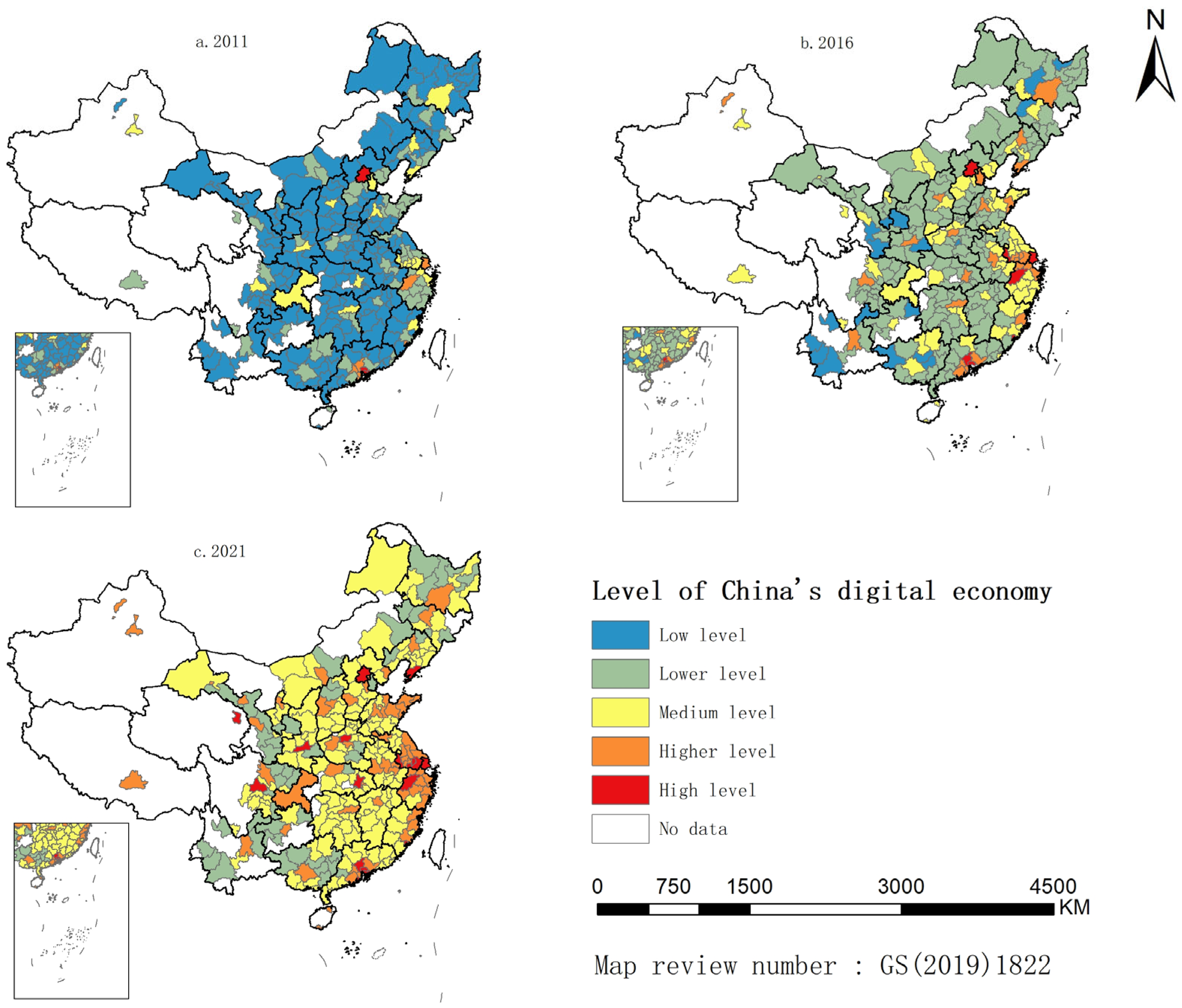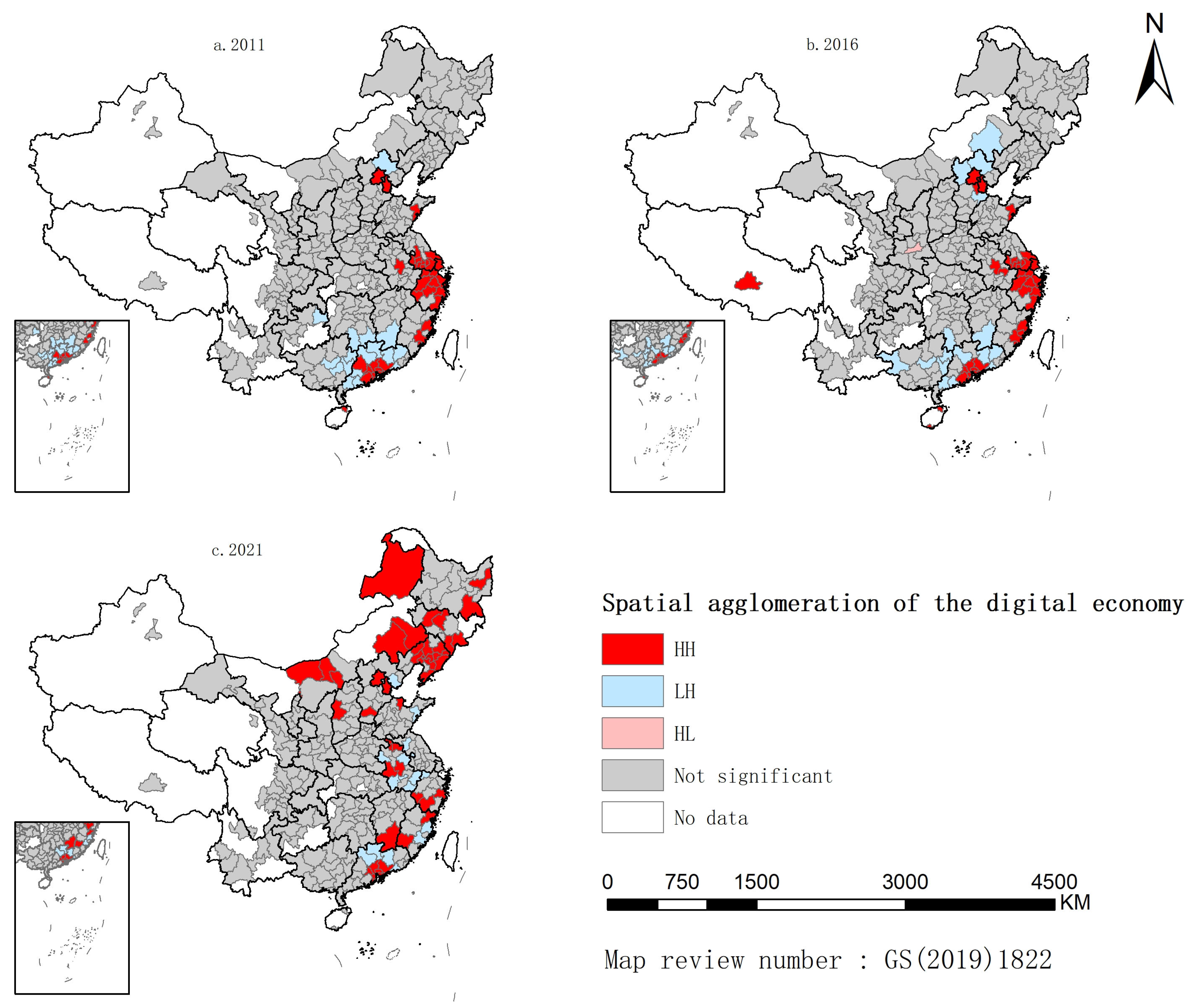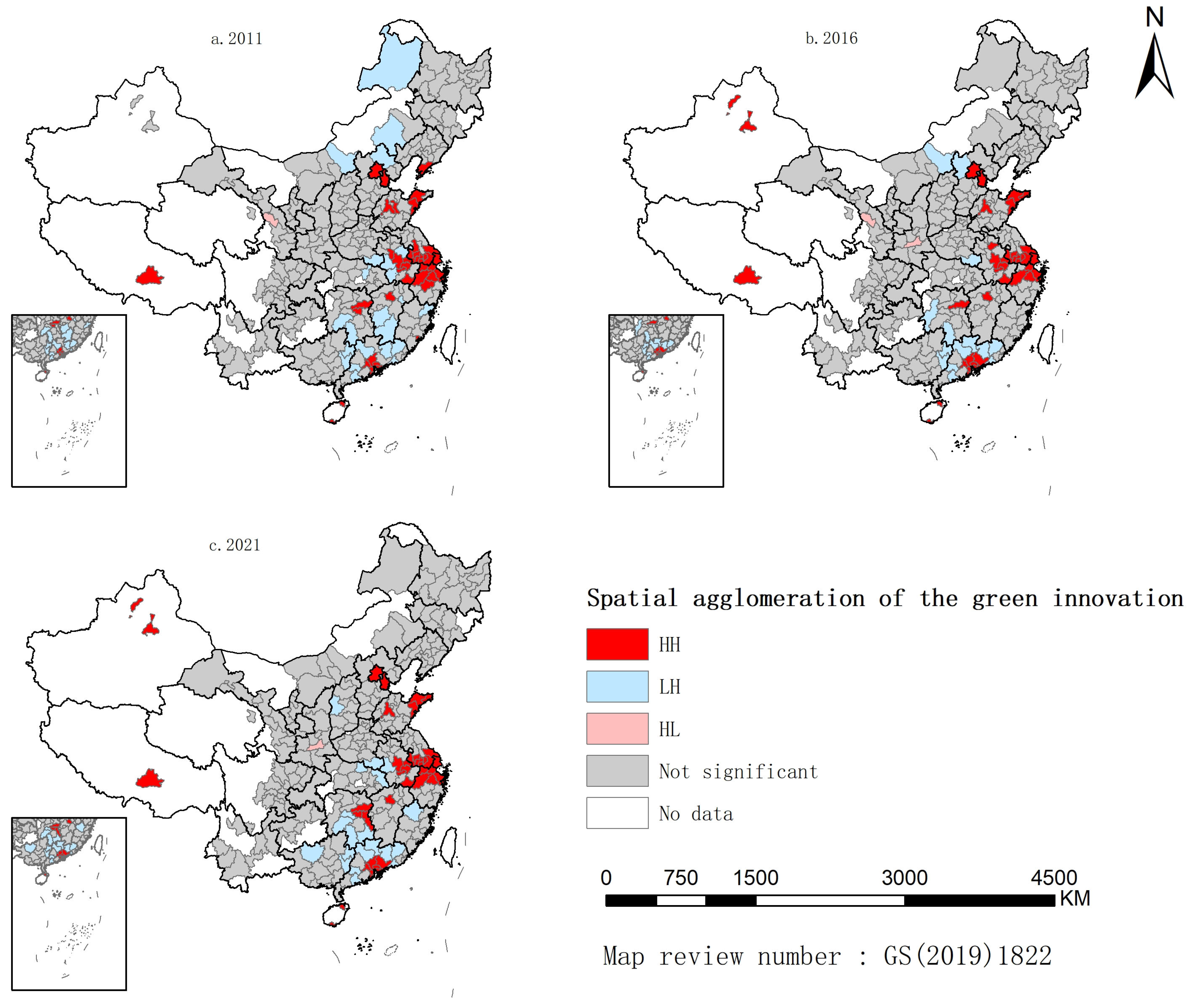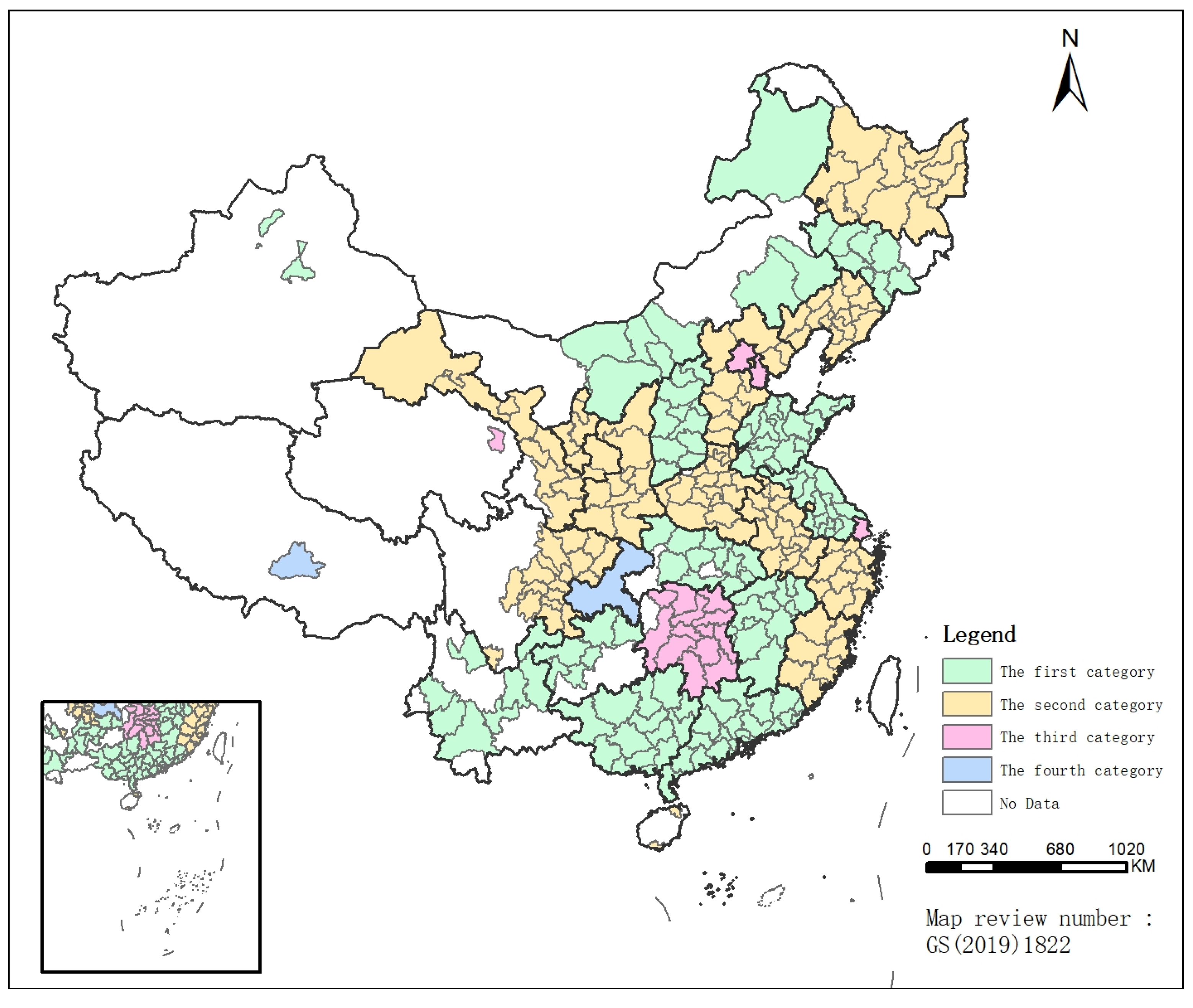2. Literature Review
Through the combing of the viewpoints in the existing literature on the digital economy and green innovation, it is found that, after several years of development and research, the academic community has achieved some progress in identifying the connotations of the digital economy [
8] and green innovation [
9,
10], and the current research mainly focuses on empirical analysis, including indicator systems and measurements, research on influencing factors, and research on the interrelationship between the two.
In terms of the construction and measurement of an indicator system, regarding the digital economy, studies have focused on constructing a multi-dimensional, comprehensive evaluation system from the perspectives of digital industrialization, industrial digitization, digital governance [
11], and digital infrastructure [
12]. The research methodologies mainly include principal component analysis [
13], the entropy value method [
14], and other objective methods, seeking to comprehensively evaluate the level of development of the digital economy. Regarding green innovation, three main types of measures are commonly used. The first aims to establish a comprehensive evaluation index reflecting the green innovation capacity; the constructed system usually includes dimensions such as innovation input, innovation output, and green development [
15,
16]. Secondly, green innovation is measured from the perspective of efficiency, and the methods used include data envelopment analysis (DEA) [
17,
18] and the SBM model of non-expected outputs [
5]. Thirdly, the number of green patents is used as a proxy variable for green innovation [
19,
20].
In terms of impact factor studies, since the 20th century, the impact of the digital economy on regional development has been increasingly emphasized by researchers. Its impact is reflected in various aspects, such as promoting economic development [
21,
22], reducing carbon emissions [
23], enhancing the regional innovation capacity [
24], and facilitating industrial transformation and upgrading [
25]. The factors that influence green innovation are diverse and include government intervention [
26], foreign investment [
27], the economic development level [
28], and the industrial structure [
29].
As the digital economy and green innovation development will become the mainstream of China’s economic development, the amount of literature exploring the interrelationship between the two is gradually increasing. In terms of theoretical research, some scholars have summarized three specific methods of enhancing the efficiency of green technological innovation in enterprises empowered by the digital economy—namely, digital technology upgrading, the all-round synergistic cooperation mode, and the standardized thinking mode. Moreover, the challenges currently faced have been analyzed [
30]. Empirical studies have shown that the development and application of digital technology [
31] and enterprise digital transformation [
32] can significantly promote green innovation, and the degree of coupling and coordination between China’s digital economy and green innovation is gradually rising, while regional differences exhibit a downward trend [
33,
34]. The digital economy significantly promotes green technological innovation in cities [
1], and this positive impact has spatial spillover effects [
35]. The digital government plays an important role in enabling green innovation in the digital economy [
36]. However, some scholars believe that the expansion of the scale of digitalization does not necessarily promote green innovation [
37]. Some studies have found that the development of the digital economy has a U-shaped influence on regional green innovation, characterized by an inhibitory effect followed by a promotional effect [
38].
In general, the existing literature contains extensive information about the digital economy and regional green innovation, with a number of relevant research results. Several studies have shown that the digital economy has a significant role in promoting green innovation; this provides a strong theoretical basis and empirical support for the impact of the digital economy on regional green innovation. However, a summary of the available studies reveals that most of them are based on an economic perspective, involving the direct construction of econometric models to measure the relationship between the two roles [
39,
40,
41], and they rarely consider the temporal evolution, spatial distribution, spatial agglomeration, and spatial–temporal evolution of the digital economy and green innovation from a geographic point of view. Moreover, for the analysis of heterogeneity, fewer studies on temporal heterogeneity have been conducted. Most of the current studies on regional heterogeneity analyze the division of China into several regions based on geographic location [
1,
4,
42], ignoring the fact that cities in different provinces within the same region also differ in their development and cannot be generalized. Based on this, this research took 287 cities in China as the study area and used the entropy method, Markov chain, spatial Markov transfer probability matrix, and spatial autocorrelation methods to explore the overall development trend in China’s digital economy and green innovation in the period 2011–2021; further analyzed the trends in changes in different sub-dimensions; and summarized the spatial distribution and agglomeration characteristics of the digital economy and green innovation. The impact of the digital economy on green innovation was analyzed using the spatial Durbin model to further investigate its temporal and spatial heterogeneity. The purpose of this study was to summarize the spatial and temporal evolution characteristics of China’s digital economy and green innovation from a geographic perspective, and to explore the impact of the digital economy on green innovation and its temporal and spatial heterogeneity, as well as to enhance China’s digital economy and green innovation and to achieve a benign interaction between the two. The possible contributions of this paper are as follows: (1) summarizing the trends in the digital economy and green innovation in Chinese cities for each dimension in order to grasp the main driving factors; (2) applying Markov and spatial Markov transfer probability matrices to analyze the temporal and spatial evolutionary patterns in China’s digital economy and green innovation, to reveal the dynamic evolutionary process and the change probability of China’s digital economy and green innovation and to demonstrate the impact of spatial correlation on the transfer probability; (3) analyzing the impact of the digital economy on green innovation at different stages and the causes, and revealing the roles of national policies and market demand factors; (4) not limiting ourselves to dividing China’s city types according to geographic location, but rather dividing them based on the results of this study, which is more in line with the actual situation of urban development and is conducive to the formulation of development policies according to the characteristics of different regions.
5. Discussion
The time change law of China’s digital economy and green innovation shows that, as a whole, both of them showed an upward trend, indicating that China achieved certain development results during this 11-year period, and is expected to maintain the momentum of continuing to rise in the future, but numerically, there is still much room for improvement. In addition, this study innovatively summarizes the pattern of change in the sub-dimensions, which provides a new perspective and direction for academic research and helps us to explore the intrinsic power mechanism of the digital economy and green innovation in depth. From the perspective of the digital economy sub-dimension, the main driving force promoting the level of the digital economy is digital innovation and digital application. On the one hand, China’s overall innovation vitality is strong, and digital innovation occupies an important position in the development of the digital economy, being the key driving force leading the development of the latter. On the other hand, thanks to the continuous improvements in Internet infrastructure and the rapid development of financial technology, as well as the extensive promotion and application of digital inclusive finance, the level of digital application has significantly increased, causing the popularity and depth of application of the digital economy in cities to continue to expand. The slow increase in the level of digital infrastructure and digital industry may be constrained by the gradual saturation of the mobile phone market in urban areas, the limited number of new subscribers, and the relatively small market size of computer services, the software industry, and the telecommunications industry. In terms of the green innovation sub-dimension, the green innovation output is the main driving force raising the level of green innovation, which is a joint result of market demand-driven and technology advancement-led changes. On the one hand, the growing consumer demand for green products and services has prompted companies to increase their investment in patents for green inventions, while, on the other hand, the constant innovation in technological methods has made it possible to create better green products. The increase in investment in green innovation plays a certain role in promoting green innovation, and the increase in the proportion of science and technology expenditure has led to more funds being used in the field of green innovation research and development, while the popularization of tertiary education has cultivated a larger number of potential talents for green innovation and provided talent support. The small increase in the green innovation foundation may be due to the fact that Chinese cities already have sufficient green space, and, given the limited urban land resources, an increase in green space appears to be insignificant in the process of economic development and the construction of other infrastructure. Meanwhile, most cities have already achieved 100% environmentally sound waste disposal, making the overall improvement in this value small.
From the perspective of the spatial distribution and agglomeration of the digital economy and green innovation, the cities with a higher digital economy and green innovation levels are mainly concentrated in the eastern coastal region, gradually spreading to the central and western regions. Meanwhile, the developed city clusters, such as the Yangtze River Delta, the Pearl River Delta, and Beijing–Tianjin–Hebei, which have a higher level of economy, industrial synergy, and innovative resources, have improved the depth of the development of the digital economy and green innovation. These three city clusters have consistently occupied the leading position, with outstanding levels of green innovation, in line with the conclusions of existing studies [
54]. However, this study also found that the gap between the digital economy and green innovation levels among different cities is narrowing, although overall, it still shows spatial imbalance characteristics. In particular, it can be seen from the LISA map of the digital economy that HH-type cities are no longer concentrated in the southeast coastal area but spread to the north, and the spatial agglomeration pattern has gradually developed from the dominance of the east coast to a more balanced situation, which is closely related to the national strategy of coordinated regional development. The results of the Markov chain show that both China’s digital economy and green innovation show obvious growth inertia and path-dependence characteristics; it is more difficult to achieve cross-level transfer, and a continuous investment in resource elements such as capital, talents, and technology is still required. The level of digital economy and green innovation can be achieved after a period of accumulation. At the same time, the spatial spillover effect of neighboring regions reveals that, in order to improve the digital economy and green innovation, we should not only focus on promoting the development of a single city, but also plan the development of the region as a whole from the perspective of the overall situation, and give full play to the spatial spillover effect, to achieve common progress.
From the results regarding the impact of China’s digital economy on green innovation, it can be seen that the development of the digital economy plays a significant role in promoting green innovation in a given region and its neighboring regions, which is in line with existing work [
55]. The digital economy has the advantages of low costs and high mobility, enhances spatial mobility [
56], reduces the cost of innovation, enhances the technological innovation of the city [
57], and provides a good foundation for the development of green innovation. At the same time, it shortens the spatial distance of information transmission through improved convenience and efficiency [
58], enabling the prosperity of one region’s digital economy to influence that of the surrounding areas and driving enhancements in the level of green innovation in neighboring cities. Meanwhile, similar to the findings of existing studies [
40], this study found that economic development in the control variables produced negative spatial spillover effects, which may be due to the existence of the “siphon effect”, leading to the concentration of green innovation resources in more developed cities. This negative effect also renders the total effect of economic development on green innovation insignificant. Similarly, interregional competition and uncoordinated financial investment may lead to the loss of development resources in neighboring cities, restricting the level of green innovation. The direct negative effect of foreign investment supports the “pollution paradise” hypothesis [
40], but foreign investment will greatly increase the enthusiasm for green innovation in neighboring regions, and its spatial spillover effect will play an important role in overall green innovation.
In addition, the difference in the impact of the digital economy on green innovation between the two phases reflects the impact of the implementation of development policies at different stages [
13]. During the 12th Five-Year Plan period, the Government, guided by the concept of green and low-carbon development, has made great efforts to develop a circular economy and promote green and innovative development in many ways. The focus on cultivating and developing the new-generation information technology industry as a strategic emerging industry has promoted the popularization of the Internet and the initial application of information and communications technology, while the construction of digital economic infrastructure has generated technological spillover effects. The “implementation of the overall strategy for regional development” proposed at this stage has led to frequent interregional industrial cooperation and technological exchanges, making it easier for enterprises in neighboring regions to access information and technologies related to green innovation, and promoting innovation in energy-saving and emission-reducing technologies, green product design, and other aspects. During the 13th Five-Year Plan period, the state proposed accelerating the construction of a “Digital China”, accelerating the implementation of the national big data strategy and other major policies, and ensuring the rapid growth of innovation activities [
59], providing strong impetus for the development of green innovation. It has been shown that, when government regulation reaches a certain level, it can promote the diffusion of green innovation [
60]. In the future, how China can formulate appropriate development strategies, implement effective regulation and supervision, and give full play to the positive effects of the digital economy on green innovation are important issues to be considered. From the perspective of changes in market demand, market demand is positively correlated with the level of green innovation [
61]. From the 12th Five-Year Plan period to the 13th Five-Year Plan period, the market demand for green products and services has shown explosive growth [
60], and enterprises have increased their technological investment in order to fulfill their social responsibility as well as to enhance the value and competitiveness of their products [
62,
63], which stimulates improvements in the level of technological innovation. In this process, the digital economy not only provides technical support for green innovation but also plays an important leading role in business models, industrial ecology, and other aspects [
64], becoming an important force promoting the development of green innovation.
The study of regional heterogeneity classifies Chinese cities into four categories, which is different from the traditional classification based on geographic location and is more in line with the actual situation in China. The majority of Chinese cities currently fall into the first and second categories, where the development of the digital economy has significantly contributed to the level of green innovation. Regarding the third category of cities, the impact of the digital economy on green innovation in Beijing, Tianjin, and Shanghai is not significant. On the one hand, this may be due to the fact that the basic level of green innovation in the municipalities is high, so the marginal contribution of each additional unit of the digital economy to green innovation is relatively small, which leads to insignificant results. On the other hand, this finding may have been due to the limited sample size.
Based on the above conclusions, we propose the following suggestions regarding how to promote the level of China’s digital economy and green innovation and to continuously utilize the “digital dividend” to promote the development of regional green innovation.
(1) Address the shortcomings, exploit the advantages, and continuously improve the digital economy and green innovation. As far as the digital economy is concerned, we should continue to increase our investment in research and development in the context of digital technology innovation, support research into both core and cutting-edge technologies, and promote the sharing and transformation of digital achievements. It is necessary to encourage the digital transformation of enterprises and promote the application and integration of digital technologies in various fields. Regarding green innovation, enterprises should be encouraged to adopt cleaner production technologies and processes to reduce their pollutant emissions. The government should continue to invest in areas such as green technology R&D and green innovation talent training, as well as provide financial support and talent security.
(2) Enhance the promotional effect of the digital economy on green innovation in different regions according to the local conditions and differential development. In the first and second types of cities, the main effects of the digital economy should be exploited to promote industrial digitization and green transformation and create green digital industry clusters. The cities in the third category should increase their investments in the digital economy, build smart factories and green supply chains, encourage the application of digital technology in green industries, and exploit the positive effects of the digital economy. The cities in the fourth category should continue to address their own shortcomings, strengthen their basic research and development, and pursue the penetration and integration of the digital economy into the industry.
(3) Strengthen cooperation, coordinate development, and exploit the driving role of advanced regions. It is necessary to strengthen the collaborative development of industries and regional cooperation and exchange between different cities, form a cross-regional green innovation collaborative development chain, achieve the sharing of resources to complement one another’s advantages, and continuously address the “siphon effect” of economic development. The central financial administration has set up special funds for the digital economy to promote green innovation; it focuses on supporting projects in advanced regions to help other regions, promoting infrastructure sharing and cooperation in green technology research and development among cities, and promoting the implementation and transformation of green invention and patent results.
6. Conclusions
Based on the panel data of 287 cities in China from 2011 to 2021, we quantified the level of the digital economy and green innovation in each city using the entropy value method, and we used spatial autocorrelation and Markov and spatial Markov probability transfer matrices to analyze the change patterns over time, the spatial distribution and agglomeration characteristics, and the spatial evolution of the digital economy and green innovation. We then constructed a spatial Durbin model to empirically analyze the impact of the digital economy on green innovation, and temporal and spatial heterogeneity analyses were carried out. The main conclusions are as follows.
(1) The level of digital economy and green innovation in Chinese cities showed an upward trend during the study period. In terms of sub-dimensions, the rapid development of digital applications and digital innovation is the main driving force for improvements in the digital economy; an increase in green innovation output plays an important role in the development of green innovation.
(2) The digital economy and green innovation in Chinese cities show a spatial pattern of “high in the east and low in the west”, with spatial agglomeration dominated by the HH type and LH type, and the Beijing–Tianjin–Hebei, Yangtze River Delta, and Pearl River Delta city clusters have outstanding levels of development, but the level of development has increased over time.
(3) The change in the digital economy and green innovation types in Chinese cities shows the phenomenon of “club convergence”, and a type transfer basically occurs between neighboring types, which makes it difficult to achieve a jump transfer. The spatial spillover effect affects the probability of type transfer, and neighboring regions with high digital economy levels will have positive spillover effects on this region, while neighboring regions with low green innovation levels will have negative spillover effects on this region.
(4) The digital economy significantly promotes the regional green innovation level, and this effect has spatial spillover effects. Comparing the impacts of different stages, the spatial spillover effect of the digital economy in the 12th Five-Year Plan period was larger, and the direct impact of the digital economy in the 13th Five-Year Plan period was more significant. According to the impact of the digital economy on green innovation, cities can be divided into four types, and most cities in China belong to the first and second types, where the digital economy significantly contributes to the enhancement of the level of green innovation.
This study summarizes the spatial and temporal evolution of the digital economy and green innovation in Chinese cities from a geographical perspective, which facilitates the understanding of the characteristics of different stages of development and expands the relevance of the study. In addition, this study examined the impact of temporal heterogeneity between the 12th and 13th Five-Year Plan phases, and discusses the roles of changes in policy and market demand. Based on the results of this study, the city types were classified, which will be helpful for governments in formulating development strategies according to the actual situations of regional development, and provide reference and policy suggestions for continuous improvements in China’s digital economy and green innovation, as well as for the development of green innovation empowered by the digital economy. However, this study encountered some challenges, which should be addressed in future research. Firstly, due to the limited availability of data, a comprehensive set of individual indicators could not be included in the evaluation index system, and the number of selected control variables was small. Therefore, in the future, it will be necessary to further improve the evaluation index system and consider the impacts of other control factors on green innovation. Secondly, due to the relatively new nature of research into the digital economy, data for some measurement indicators prior to 2011 were lacking, so the research period was relatively short. The relatively long time span required for the effects of digital economy-enabled green innovation to emerge may have impacted this study’s conclusions. Ongoing follow-up research is needed to further clarify the impact of the digital economy on the level of green innovation.
